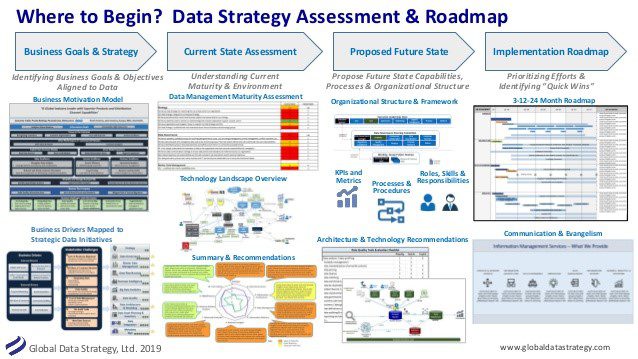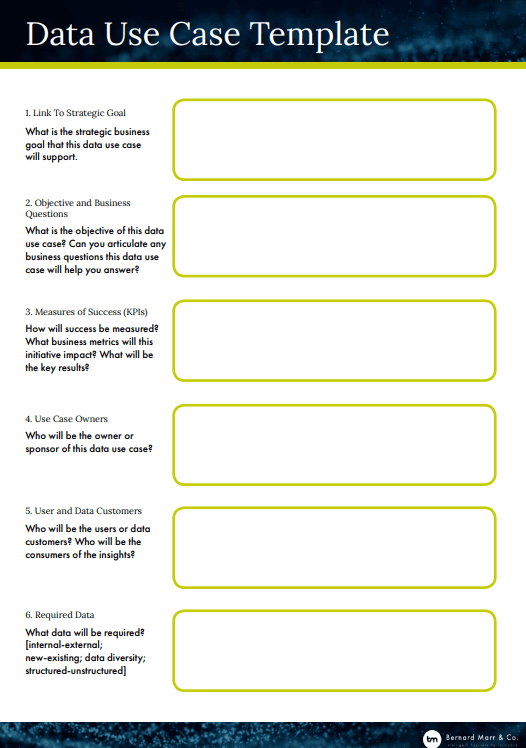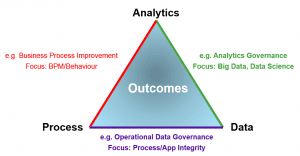
Creating a Data Strategy, like a Business Strategy, is an art. In a Harvard Business Review article, Joshua Gans, professor at the University of Toronto's Rotman School of Management, notes two typical errors made with a Business Strategy: spending too much time searching for the one true strategy and getting paralyzed by uncertainty — hence, not doing any planning. The same could be said about Data Strategy. Spend too much time on getting a Data Strategy perfect, and risk an unhappy customer who should, but who does not, have access to critical functionality. Take a reactionary approach and end up with a week-long company shutdown due to a ransomware infection or something similar.
In addition to efficiently using time in Data Strategy planning, companies need to create the Data Strategy that aligns to a Business Strategy.
As Donna Burbank, the Managing Director of Global Data Strategy, stated in a recent webinar, Business and Data Strategies are interdependent and closely related. Without coordinating Business and Data Strategies, data remains stuck in silos or has a poor quality or there are process inefficiencies. The result? Unhelpful or unneeded reports gather dust, and staff goes back to Excel spreadsheets, available at their fingertips, in an attempt to meet the business needs. Efficiently creating a Data Strategy that aligns with the business means finding a systematic approach that works.
Data Strategy templates help identify business systems that work, through quick cheat sheets. This article will define what is a Data Strategy, why use a Data Strategy template, and some Data Strategy template examples.
What is a Data Strategy?
According to the DAMA International DMBOK, Data Strategy describes a "set of choices and decisions that together chart a high-level course of action to achieve high-level goals." This includes business plans to use information to a competitive advantage and to support enterprise goals.
Donna Burbank eloquently stated that a Data Strategy is:
"The opportunity to take your existing product line and market it better, develop it better, use it to improve customer service, or to get a 360-degree understanding of your customer. Data Strategy is driven by your organization's overall Business Strategy and business model."
Data Strategies benefit businesses by exploring the underlying relationships between the overall business, technology, and Data Strategy goals. By creating a Data Strategy that works for the business model, Data Management activities stay on track. Also, it brings "predictive capabilities and even prescriptive recommended actions into production at scale," as Doug Henschen, Vice President and Principal Analyst at Constellation Research noted. Finally, a good Data Strategy provides good measurements.
Why a Data Strategy Template?
First, many companies may be confusing Data Management (e.g., ensuring databases are running, optimized, and the day-to-day operations are smooth) for a Data Strategy. Business may not be thinking long-term and strategically in managing data, but instead may just be getting by.
In addition, data volume, speed, and the variety of data and technologies continue to change rapidly. This means business contexts quickly alter. The Data Strategy six months ago may not be adequate. Consequently, an unstable framework that supports a Data Strategy starts to break down. For example, a Commvault notes while enterprises are opening their wallets to cloud spending, very few have a well-developed Data Strategy for this newer technology. As a result, Data Management errors in security, access, and business execution (people, processes, and technologies) will probably develop in the near future.
Finally, Data Strategy needs to be thought out well and highly dynamic, to support the acquisition, organization, analysis, and delivery of data in support of business objectives. A Data Strategy template fits this need. It can be reused and adapted but keep to the business's line and goals. This, in turn, focuses a manager's attention more effectively, and prevents Data Strategy planning from being too long or too short. Furthermore, it is a way of checking alignment between the Business and Data Strategies.
BCPI Template
The BCPI template models Data Strategy as a lever to achieve its objectives, just like using a lever to move a bolder up on top of a stone wall. Those involved need to know the businesses' end purpose. They need to know the capabilities of the people using the lever and the materials available. The manager needs to know the steps to get to the final product. The four-step Data Strategy creation process can be seen in Figure 1.
Building a Data Strategy Template

The steps are:
- Business Goals and Strategy: Identifying business goals and objectives aligned to data
- Current State Assessment: Understanding the current maturity and environment.
- Proposed Future State: Propose future state capabilities, processes, and organizational Structure.
- Implementation Roadmap: Prioritizing efforts and identifying "quick wins."
Donna Burbank's webinar provides a customizable system, through choices of models, frameworks, recommendations, etc., under each Data Strategy planning stage.
Data Use Case Template
Bernard Marr designed a Data Use Case Template (Figure 2) based on use cases. He goes into detail regarding areas business must consider. Marr recommends developing three to five use cases, including those identified as major or which take up more time and quick wins. The quick wins help demonstrate the value of a Data Strategy.

Marr's data template has eleven sections to complete:
- Link to Strategic Goal: The business goal the Data Use Case template is designed to support
- Objective and Business Questions: Details data-related goals and business questions necessary to link to the strategic goal.
- Measure of Successes (KPI): Definitions of what success and progress looks like for this use case.
- Use Case Owner: Person or people who own this use case, typically a manager with a team.
- User and Data Customers: The people, both internal and external, using the data.
- Required data: Data sets needed, including unstructured, internal, and external data.
- Data Governance: Data Quality, ethics, privacy, ownership, access rights, and security to keep the data safe.
- Data Analysis: Processes to figure out how to turn data into insights to help the business.
- Technology: Software and hardware needed to collect, store, and analyze the data, as well as communicate results.
- Skills and capacity: Human resources needed to make the Data Strategy use case happen.
- Implementation and Change Management: Roadblocksand implementation requirements to ensure Data Use Case success.
Marr recommends reusing this template for each the separate use case and assumes multiple Data Use Cases. That way a manager can prioritize and decide what to tackle first.
Data and Analytics Strategy
Andrew White, a member of the Gartner Blog Network, writes about the challenges in reviewing Data Strategy documentation. The majority do not refer to measurable results and confuse Data Strategy with plans, decisions, goal, or directions. Furthermore, current terminology does not describe which strategies refer to operations versus analytics or a combination of the two. So White came up with a graphic, Figure 3.

The triangulation is based on a concept Valerie Logan developed, noting that productions are now people, process, technology, AND data. The Data Strategy Template is designed to focus on how data is used. Based on this template, businesses can get a sense of their data use ontology. The end goal is to get a sense of how business outcomes may work and change with the data.
Data Strategy templates provide a methodology toward ensuring the data is aligned with business strategies. It reduces the tendency to create a document that no one will read — or to not to get started at all. One Data Strategy template does not fit all. This article has covered only three Data templates; others may be available.
Of the Data Strategy templates discussed, the BCPI approach simplifies how to align with business strategies and see the process unfold over time. The Data Use Case methodology is similar in using Agile sprints toward developing a larger software product, but instead of breaking each sprint into user stories, it chunks the larger Data Strategy. The triangulation uses what the business does to develop the Data Strategy. All methods provide Data Strategy templates on hand, to get started.
Image used under license from Shutterstock.com
Source: https://www.dataversity.net/developing-a-data-strategy-template/
Posted by: darelldarellloiaconae0269237.blogspot.com